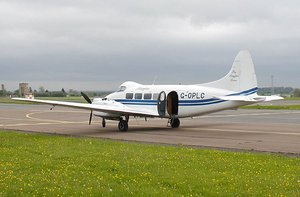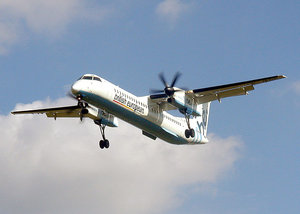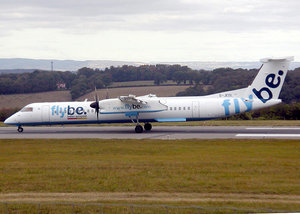De Havilland
|
|
| Contents |
de Havilland UK
In 1920 Geoffrey de Havilland changed the name of his company Airco, where he had previously been chief designer, to the De Havilland Aircraft Company.
The new company was based at Hatfield, in Hertfordshire, England.
Initially de Havilland concentrated on single and two seat biplanes, essentially continuing the DH line of aircraft built by Airco, but engined with de Havillands own Gypsy engines. These included the Gipsy and Tiger Moths. These aircraft set many aviation records, many piloted by de Havilland himself. Amy Johnson flew solo from England to Australia in a Gypsy Moth in 1930, the flight taking 19.5 days.
Dh.foxmoth.750pix.jpg
The Moth line of aircraft continued with the more refined (and enclosed) Hornet Moth and Moth Minor, the later being a low wing monoplane constructed of wood.
De Havilland continued to produce high performance aircraft including the high speed twin piston engine DH.88 Comet mailplane, one of which became famous in its red livery as the winner of the MacRobertson Air Race from England to Australia.
The high performance designs and wooden construction methods culminated in perhaps the most famous De Havilland aircraft - the Mosquito, constructed primarily of wood because of the shortage of aluminium during the war.
After the Second World War De Havilland continued with leading edge designs in both the military and civil field, but several public disasters doomed the company as an independent entity. The De Havilland Comet was put into service in 1952 as the eagerly-anticipated first commercial jet airliner, twice as fast as previous alternatives and a source of British national pride. The Comet suffered three tragic and high-profile crashes in two years. Less well known, but equally disastrous, was the explosion of the Sea Vixen prototype during the 1952 Farnborough Air Show, which also killed members of the public.
De Havillands was bought by Hawker-Siddeley, before incorporation into British Aerospace. In this period many designs started by De Havilland came into production including the Trident, HS-146 (later BAe-146), HS-125, (later BAe-125).
De Havilland Aircraft:
- Biplanes
- Piston Monoplanes
- Civil Jets
- Military Jets
de Havilland Canada
De Havilland Canada was formed in 1928 to build Moth aircraft for the training of Canadian airmen and continued after the war to build its own designs suited to the harsh Canadian operating environment. These are listed below. The DHC-2 through DHC-7 aircraft were all STOL designs. De Havilland (Canada) was eventually incorporated into the Bombardier group of companies and the Dash Eight remains in production with a particular emphasis being placed on its quiet operation in comparison to other aircraft of a similar size. In May of 2005, Bombardier sold the rights to the out-of-production aircraft (DHC-1 through DHC-7) to Viking Air Ltd. of Sidney, British Columbia.
De Havilland (Canada) Aircraft (chronologically):
- DHC-1 Chipmunk nicknamed the Chippy
- DHC-2 Beaver
- DHC-3 Otter
- DHC-4 Caribou
- DHC-5 Buffalo
- DHC-6 Twin Otter
- DHC-7 Dash-7
- DHC-8 Dash-8
de Havilland Australia
De Havilland's first foreign subsidiary was set up in Australia during in March 1927. The company moved to Sydney during 1930 where it acted as an agency for the parent company, with assembly, repair and spares facilities for the company's popular sporting and airliner types. Aircraft design and full manufacture by de Havilland Australia did not take place until WWII, when the company began production of the DH-82 Tiger Moth primary trainer at Bankstown, NSW.
During the Second World War the Australian company began to manufacture the Mosquito with deliveries to the RAAF being first made in 1944. A totol of 212 Mosquitos were built at Bankstown between 1943 and 1948. Some of these aircraft continued in RAAF service until 1953.
License production of the de Havilland Vampire had begun by 1946.
A completely indigenous design, the DHA-3 Drover, was manufactured although only about 20 were produced, mostly for the Royal Flying Doctor Service (RFDS). some were also operated by Trans Australia Airlines and QANTAS. Production of these aircraft took place between 1948 and 1952. The DHA-3 Drover was a 3-engined light transport capable of carrying 6 - 8 passengers designed as a replacement for the de Havilland DH-84 Dragon which was common in Australia at the time. The engine chosed for the new design was the 3 De Havilland Gipsy Major Mk-10 4. Several Drovers were later re-engined with with Lycoming flat 4 engines.
Trivia
- The site of the former Hatfield Aerodrome, where de Havilland was based, is now used by the University of Hertfordshire for its de Havilland campus, which opened in 2003. The site also includes a business park and The Galleria shopping centre. As well as the university campus, the area also includes several streets named after de Havilland aircraft [1] (http://www.streetmap.co.uk/newmap.srf?x=521250&y=208750&z=1&sv=521250,208750&st=4&ar=N&mapp=newmap.srf&searchp=newsearch.srf).
External links
|
Lists of Aircraft | Aircraft manufacturers | Aircraft engines | Aircraft engine manufacturers Airports | Airlines | Air forces | Aircraft weapons | Missiles | Timeline of aviation |



